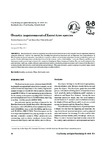Please use this identifier to cite or link to this item:
http://www.alice.cnptia.embrapa.br/alice/handle/doc/899318| Title: | Genetic improvement of forest tree species. |
| Authors: | ASSIS, T. F.  RESENDE, M. D. V. de   |
| Affiliation: | Teotônio Francisco Assis, Assistech Ltda; MARCOS DEON VILELA DE RESENDE, CNPF. |
| Date Issued: | 2011 |
| Citation: | Crop Breeding and Applied Biotechnology, Viçosa, MG, S1, p. 44-49, June 2011. |
| Description: | Brazilian forestry sector is considered one of the most developed in the world, being the base for important industrial segments which use wood as raw material. Tree breeding has played an important role on improving the competitiveness of Brazilian forestry-based companies, especially for its positive reflexes on increasing adaptation, forestry productivity and wood quality. In spite of the importance of other forest trees for the economy, such as Schizolobium, Araucaria, Populus and Hevea, the main genera under genetic improvement in the country are Eucalyptus, Pinus, Acacia and Tectona. They are used by industries like pulp and paper, siderurgy, tannin, chips for exportation and lumber, constituting an important source of revenues for the Brazilian?s economy, besides their positive social and environmental impacts. This paper presents a generic approach to genetic improvement aspects of these four major genera currently undergoing breeding in Brazil. |
| Thesagro: | Acácia |
| NAL Thesaurus: | Eucalyptus Pinus Tectona breeding |
| Keywords: | Melhoramento genético |
| Notes: | Especial issue. |
| Type of Material: | Artigo de periódico |
| Access: | openAccess |
| Appears in Collections: | Artigo em periódico indexado (CNPF)  |










